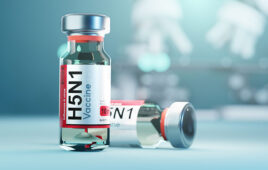Tumors shrank or disappeared and disease progression was temporarily halted in 15 children with advanced neuroblastoma enrolled in a safety study of an experimental antibody produced at St. Jude Children’s Research Hospital. Four patients are still alive after more than two-and-a-half years and without additional treatment.
Findings from the Phase I study were published online in the Journal of Clinical Oncology.
The results prompted St. Jude to expand clinical trials of the monoclonal antibody hu14.18K322A to include patients newly diagnosed with neuroblastoma. Monoclonal antibodies are engineered in the laboratory to recognize and attach to specific markers carried on the cell surface.
Neuroblastoma is a cancer of the sympathetic nervous system. It is the most common cancer diagnosed in the first year of life and accounts for 7 to 10% of childhood cancers. While certain patients, particularly infants, enjoy cure rates of 90% or better, the outlook is worse for high-risk patients, including those whose disease has spread widely. New treatments are urgently needed for these patients, less than half of whom currently enjoy long-term, disease-free survival.
“This was the first time this experimental antibody was tried in patients. We were encouraged with the response,” said first and corresponding author Fariba Navid, MD, an associate member of the St. Jude Dept. of Oncology. “The percentage of patients who benefited from treatment with hu14.18K322A was unusual for a Phase I study.” Phase I studies focus on questions related to the safety and best dose of experimental therapies. The research involves patient volunteers whose cancer has returned or did not respond to standard treatment, which for neuroblastoma includes surgery, chemotherapy, radiation and bone marrow transplants.
In this study, 38 St. Jude patients received one of nine different doses of hu14.18K322A. The immunotherapy is designed to activate the disease-fighting immune system to attack and kill tumor cells. Every 28 days, patients received an infusion of hu14.18K322A once daily for four days.
Of the 31 patients evaluated after two or more rounds of treatment, the disease stabilized in nine patients, tumors shrank in two patients and were undetectable in four more, researchers reported. “Four patients are alive after more than two-and-a-half years without additional therapy,” Navid said.
Hu14.18K322A is an antibody engineered to recognize and attach to a molecule called the GD2 antigen. GD2 is found on the surface of almost all neuroblastoma cells as well as other tumors, including the skin cancer melanoma, the bone cancer osteosarcoma and soft-tissue sarcomas. The antigen is found on the normal cells of just a few tissues.
The antibody is produced in the Children’s GMP, LLC. Navid said the study would not have been possible without the GMP, an on-site facility that makes highly specialized medicines and other biologics under government-approved Good Manufacturing Practices regulations.
The monoclonal antibody in this study is one of several antibodies targeting GD2 that are in clinical development for treatment of neuroblastoma. Hu14.18K322A is a modified version of another antibody.
The main change, a point mutation in the human gene for hu14.18, was designed to address treatment-limiting pain by generating a more tailored response that avoided triggering part of the immune response called the complement cascade. In addition, the hu14.18K322A has fewer mouse components, making it less likely the body will reject the antibody. It is also made in a cell line that may improve its ability to kill tumor cells.
In this study, pain remained the most common side effect associated with hu14.18K322A treatment. While 68% of patients reported severe pain during the first round of treatment, Navid said the pain was manageable with medication and resolved within 24 hrs of receiving the experimental antibody. The pain also lessened with each round of therapy. While direct comparisons between patients who received hu14.18K322A and a different version of the antibody are difficult, Navid said: “Our clinical impression is that the duration and severity of pain in patients receiving hu14.18K322A are less.” Clinical trials involving hu14.18K322A continue at St. Jude.
Researchers are testing the impact of giving the monoclonal antibody weekly rather than every 28 days and in combination with other therapies.
Filed Under: Drug Discovery




